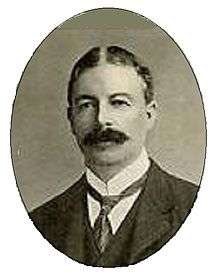Lewis Haslam

Lewis Haslam (25 April 1856 – 12 September 1922), was a Liberal Party Member of Parliament (MP) in Wales, representing Monmouth Boroughs from 1906 to 1918 and then Newport from 1918 until his death in 1922.
Family and education
Haslam was the son of John Haslam of Gilnow House in Bolton in Lancashire. He was educated at University College School and University College, London. In 1893 he married Helen Norma Dixon of Watlington, Oxfordshire.[1]
Career
Haslam was the director of cotton spinning and manufacturing companies.[2] He has been classified as a genuinely second generation self-made man and was among the most wealthy MPs of his time.[3] He also served as a Justice of the Peace for the county of Lancaster.[1]
Politics
At the 1892 general election he contested the Westhoughton Division of Lancashire, in opposition to Lord Stanley reducing the Conservative majority by 500 votes. He does not appear to have been a candidate in 1895 but in 1900 he stood in Stamford in Lincolnshire, again without success.[2]
He was eventually returned to the House of Commons at the 1906 Liberal landslide at Monmouth.
| Party | Candidate | Votes | % | ± | |
|---|---|---|---|---|---|
| Liberal | Lewis Haslam | 4,531 | 44.7 | -3.4 | |
| Conservative | E E Micholls | 3,939 | 38.8 | -13.1 | |
| Labour | James Whinstone | 1,678 | 16.5 | n/a | |
| Majority | 592 | 5.9 | 7.7 | ||
| Turnout | 90.6 | ||||
| Liberal gain from Conservative | Swing | +4.8 | |||
| Party | Candidate | Votes | % | ± | |
|---|---|---|---|---|---|
| Liberal | Lewis Haslam | 6,496 | 54.8 | +10.1 | |
| Conservative | Sir Charles William Cayzer | 5,391 | 45.2 | +6.4 | |
| Majority | 9.6 | 3.7 | |||
| Turnout | |||||
| Liberal hold | Swing | +1.9 | |||

| Party | Candidate | Votes | % | ± | |
|---|---|---|---|---|---|
| Liberal | Lewis Haslam | 6,154 | 54.9 | +0.1 | |
| Conservative | Gerald de La Pryme Hargreaves | 5,056 | 45.1 | -0.1 | |
| Majority | 1,098 | 9.8 | +0.2 | ||
| Turnout | 86.7 | ||||
| Liberal hold | Swing | -0.0 | |||
He was a supporter of the coalition government of David Lloyd George and at the 1918 was a recipient of the government coupon, gaining the support of the local Conservative and Liberal Associations.
Along with fellow Coalition Liberal Edgar Rees Jones of the Merthyr constituency, Haslam played a minor role in the discussions behind the Government of Ireland Bill.[6] Haslam in particular was strongly opposed to giving the Irish Parliament control of its own taxes.[6]
The 1922 Newport by-election held after his death marked the end of the Lloyd George Coalition Government.[7]
References
- 1 2 Who was Who, OUP 2007
- 1 2 http://lloydgeorgesociety.org.uk/resources/sites/84.234.17.197-4611481cc83403.08117414/Welsh+Liberal+MPs+elected+in+1906.pdf
- ↑ W. D. Rubinstein, Men of Property: The Very Wealthy in Britain Since the Industrial Revolution; Taylor & Francis, 1981 p86
- ↑ British parliamentary election results, 1885-1918 (Craig)
- 1 2 Debrett's House of Commons 1916
- 1 2 Tanner, Duncan (2006). Debating nationhood and governance in Britain, 1885-1945: perspectives from the 'four nations'. Manchester University Press. p. 75. ISBN 0-7190-7166-6.
- ↑ C Cook & J Ramsden, By-elections in British Politics; UCL Press, 1997 p19ff
- Craig, F. W. S. (1983) [1969]. British parliamentary election results 1918-1949 (3rd ed.). Chichester: Parliamentary Research Services. ISBN 0-900178-06-X.
- Leigh Rayment's Historical List of MPs
External links
- Hansard 1803–2005: contributions in Parliament by Lewis Haslam
| Parliament of the United Kingdom | ||
|---|---|---|
| Preceded by Joseph Lawrence |
Member of Parliament for Monmouth Boroughs 1906–1918 |
Succeeded by Leolin Forestier-Walker |
| New constituency | Member of Parliament for Newport 1918–1922 |
Succeeded by Reginald Clarry |